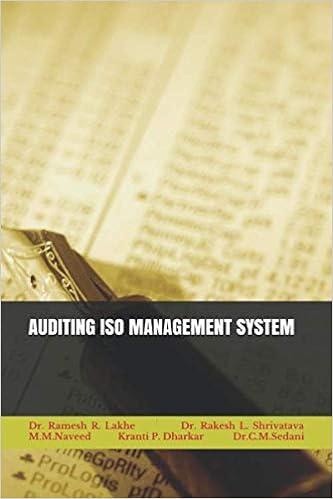Question
Accounts Receivable Gibson Co. makes most of its sales on a credit basis. Gibson uses the allowance method to account for credit losses. The company
Accounts Receivable
Gibson Co. makes most of its sales on a credit basis. Gibson uses the allowance method to account for credit losses. The company adjusts its accounts just once a year, at the December 31 year-end. Consider the following balances available from the companys unadjusted trial balance at year-end 2019:
| Account | Debit | Credit |
| Accounts receivable | 3,496,280 | |
| Allowance for doubtful accounts | 27,695 |
Gibson prepared an aging of accounts at year-end 2019, as follows:
| Age Group | Amount | Estimated % Uncollectible |
| 0-30 days | $1,813,400 | 1.0% |
| 31-60 days | 729,710 | 8.8% |
| 61-90 days | 497,160 | 21.3% |
| 91-120 days | 264,950 | 35.9% |
| Over 120 days | 191,060 | 62.4% |
| $3,496,280 |
On February 26, 2020, Gibson wrote off a sizable receivable balance, amounting to $19,267. Later, on August 11, 2020, Gibson received a check from this customer for $4,350 as partial payment on the past-due account.
4-Year Promissory Note
On December 31, 2019, Gibson received a 4-year promissory note as consideration in an inventory sale transaction on that date. The note is noninterest-bearing, and it calls for the customer to pay the full face value of $42,985 on the December 31, 2023 maturity date. The going market rate of interest for comparable notes on the issue date was 7%.
3-Year Promissory Note
On that same date (December 31, 2019), Gibson received a 3-year, 2%, $66,210 note from another customer as consideration in an inventory sale transaction. This note requires the customer to pay interest annually on December 31 (2020 through 2022). The going market rate of interest for comparable notes on the issue date was 9%.
Gibson uses the effective-interest method to amortize premiums and discounts on all of its promissory notes.
Instructions
Address the following matters related to Gibson Co.s accounts and notes receivable transactions:
- Give the adjusting entry Gibson must make on December 31, 2019 to account for estimated credit losses on its accounts receivable under each of the following two estimation approaches:
Gibson estimates that 9.25% of the year-end accounts receivable will not be collected.
Gibson estimates credit losses from the aging schedule it prepared.
- Give the entries Gibson must make to record the 2020 events related to its accounts receivable:
The write-off on February 26, 2020.
The partial collection after write-off on August 11, 2020.
- Give the entry to record Gibsons receipt of the 4-year promissory note on December 31, 2019.
- Give the interest and collection entries Gibson must make over the remaining term of the 4-year note (through December 31, 2023). Tip You might find it helpful to start by preparing an amortization schedule (see pages 7-19 and 7-20).
- Give the entry to record Gibsons receipt of the 3-year promissory note on December 31, 2019.
- Give the interest and collection entries Gibson must make over the remaining term of the 3-year note (through December 31, 2022). Tip You might find it helpful to start by preparing an amortization schedule (see pages 7-19 and 7-20).
Step by Step Solution
There are 3 Steps involved in it
Step: 1

Get Instant Access to Expert-Tailored Solutions
See step-by-step solutions with expert insights and AI powered tools for academic success
Step: 2

Step: 3

Ace Your Homework with AI
Get the answers you need in no time with our AI-driven, step-by-step assistance
Get Started


